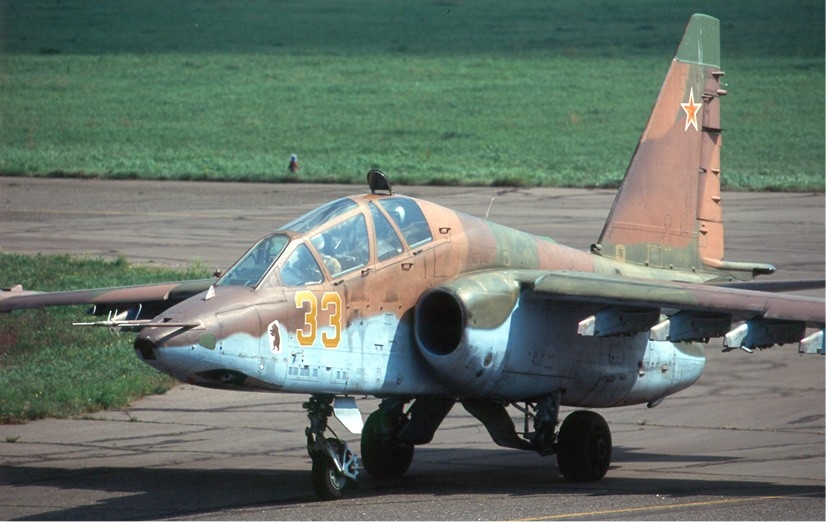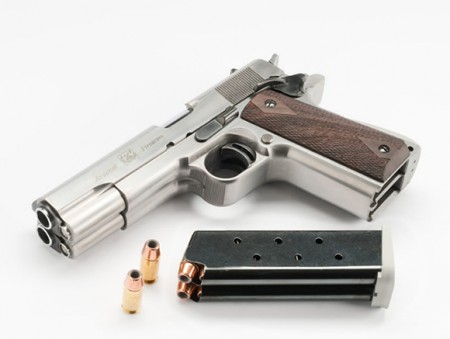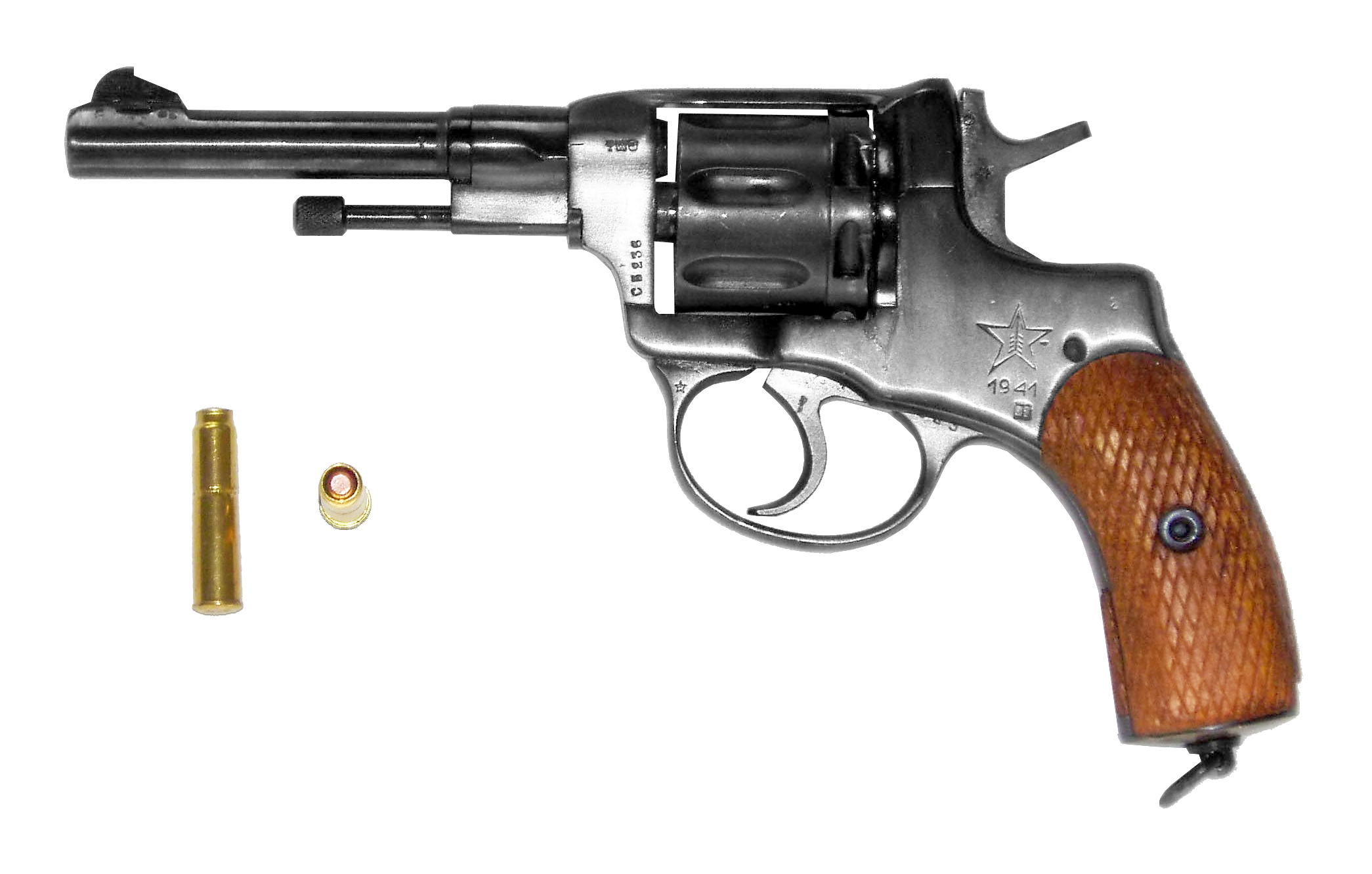|
GSh-30-2
The Gryazev-Shipunov GSh-30-2 (ГШ-30-2) or GSh-2-30 is a Soviet dual-barrel autocannon developed for use on certain ground attack military aircraft and helicopters. The cannon is not related to the Gryazev-Shipunov GSh-30-1, but is a recoil-operated cannon using the Gast principle, like the Gryazev-Shipunov GSh-23L. The GSh-30-2 was designed for the Sukhoi Su-25 ground attack plane and can also be carried in external gun pods. It measures 2,044 × 222 × 195 mm, with a barrel length of 1500 mm and a weight of 105 kg. The GSh-30K is a modified version with 2400 mm long water-cooled barrels, a variable rate of fire, and dimensions of 2,944 × 222 × 195 mm. It is used on a fixed mounting on late model Mil Mi-24 helicopters, e.g. the Mi-24P. Variants * GSh-30-2 * GSh-30-2K Specifications (GSh-30-2) * Manufacturer: KBP Instrument Design Bureau * Type: dual-barrel autocannon * Caliber: 30×165 mm, electrically primed * Operation: recoil operation * ... [...More Info...] [...Related Items...] OR: [Wikipedia] [Google] [Baidu] |
Sukhoi Su-25
The Sukhoi Su-25 ''Grach'' (russian: Грач (''rook''); NATO reporting name: Frogfoot) is a subsonic, single-seat, twin-engine jet aircraft developed in the Soviet Union by Sukhoi. It was designed to provide close air support for Soviet Ground Forces. The first prototype made its maiden flight on 22 February 1975. After testing, the aircraft went into series production in 1978 in Tbilisi in the Georgian Soviet Socialist Republic. Early variants included the Su-25UB two-seat trainer, the Su-25BM for target-towing, and the Su-25K for export customers. Some aircraft were upgraded to the Su-25SM standard in 2012. The Su-25T and the Su-25TM (also known as the Su-39) were further developments, not produced in significant numbers. The Su-25, and the Su-34, were the only armoured, fixed-wing aircraft in production in 2007.Gordon and Dawes 2004. Su-25s are in service with Russia, other CIS members, and export customers. Production of the Su-25 ended in 2017 in Russia and 2010 in Ge ... [...More Info...] [...Related Items...] OR: [Wikipedia] [Google] [Baidu] |
KBP Instrument Design Bureau
JSC ''Konstruktorskoe Buro Priborostroeniya'' (KBP) (russian: АО «Конструкторское бюро приборостроения», AO konstruktórskoje bjuró priborostrojénija Joint-Stock Company - Instrument Design Bureau) is one of the main enterprises in the field of Russian defense industry, based in Tula. It is engaged in designing high-precision weapon systems for the Army, the VMF and the VKS, as well as anti-air defense systems, high-rate-of-fire cannons and small arms, in addition to civilian products. Its full name goes as "Joint-Stock Company Instrument Design Bureau named after Academic A. G. Shipunov". Its shareholders include High Precision Systems, part of the State Corporation Rostec. The designing of high-precision weaponry is the priority of the KBP. The enterprise designs air-to-ground, ground-to-air and ground-to-ground weaponry. In addition to these, KBP also develops modern autocannons and grenade launchers. It also manufactures automatic, h ... [...More Info...] [...Related Items...] OR: [Wikipedia] [Google] [Baidu] |
Mi-24
The Mil Mi-24 (russian: Миль Ми-24; NATO reporting name: Hind) is a large helicopter gunship, attack helicopter and low-capacity troop transport with room for eight passengers. It is produced by Mil Moscow Helicopter Plant and has been operated since 1972 by the Soviet Air Force and its successors, along with 48 other nations. In NATO circles, the export versions, Mi-25 and Mi-35, are denoted with a letter suffix as "Hind D" and "Hind E". Soviet pilots called the Mi-24 the "flying tank" (russian: летающий танк, letayushchiy tank, links=no), a term used historically with the famous World War II Soviet Il-2 ''Shturmovik'' armored ground attack aircraft. More common unofficial nicknames were "Galina" (or "Galya"), "Crocodile" (russian: Крокодил, Krokodil, links=no), due to the helicopter's camouflage scheme, and "Drinking Glass" (russian: Стакан, Stakan, links=no), because of the flat glass plates that surround earlier Mi-24 variants' cockpits. D ... [...More Info...] [...Related Items...] OR: [Wikipedia] [Google] [Baidu] |
30×165mm
30 mm caliber is a specific size of popular autocannon ammunition. Such ammunition includes NATO standard 30×113mmB and 30×173mm (STANAG 4624), Soviet 30×155mmB, 30×165mm, and 30×210mmB, Yugoslav 30×192mm, Anglo-Swiss 30×170mm, and Czechoslovak 30×210mm rounds which are widely used around the world. Usage Thirty-millimeter ammunition is typically not used against personnel, but rather as an anti-materiel or armor-piercing round. Rounds of this size can be effective against lightly armored vehicles as well as fortified bunkers. It is also a popular caliber for shipboard close-in weapons systems, such as the Russian AK-630 and Dutch Goalkeeper CIWS. The Armed Forces of the Russian Federation use their 30 mm weapons in a variety of vehicles, including the Su-25 attack aircraft, Mi-24 helicopter, Mi-28 attack helicopter, Ka-50 attack helicopter, and the BMP-2, BMP-3, and BTR-90 infantry fighting vehicles. The most modern anti-aircraft gun systems in use by Russi ... [...More Info...] [...Related Items...] OR: [Wikipedia] [Google] [Baidu] |
List Of Multiple-barrel Firearms
Below is a list of multiple-barrel firearms of all forms from around the world.Small Arms Illustrated, 2010 Pistols Rifles Flare launchers Less lethal Automatic rifles Submachine guns Shotguns Machine guns Grenade launchers See also * Combination gun * Double-barreled shotgun * Lists of weapons * List of firearms * List of assault rifles * List of machine guns * List of pistols * List of semi-automatic pistols * List of revolvers * List of sniper rifles * List of grenade launchers This article lists all forms of grenade launchers around the world, that is to say weapons that launch grenades with more accuracy, a higher velocity and to greater distances than a soldier could.''Small Arms Illustrated'', 2010 Below is the ... References {{reflist multiple barrel Multiple-barrel firearms ... [...More Info...] [...Related Items...] OR: [Wikipedia] [Google] [Baidu] |
Gast Principle
The Gast gun was a German twin barrelled machine gun that was developed by Karl Gast of Vorwerk und Companie of Barmen and used during the First World War. Its unique operating system produced a very high rate of fire of 1,600 rounds per minute. The same principle was later used as the basis for the widely used Gryazev-Shipunov GSh-23L series of Russian aircraft autocannon. Description The weapon combines two barrels into a single mechanism so that the recoil from firing one barrel loads and charges the second. Ammunition feeds into the gun from two vertically mounted cylindrical drums, one on each side. The drums held 180 rounds of German 7.92 mm rifle ammunition, feeding them into the breech using a compressed spring. An experienced gunner could change ammunition drums in a few seconds. The weapon could fire single shots if one side of the mechanism had a problem. The gun's relative lightness at approximately without ammunition led to its airborne use; a telescopic s ... [...More Info...] [...Related Items...] OR: [Wikipedia] [Google] [Baidu] |
Autocannons Of The Soviet Union
An autocannon, automatic cannon or machine cannon is a fully automatic gun that is capable of rapid-firing large-caliber ( or more) armour-piercing, explosive or incendiary shells, as opposed to the smaller-caliber kinetic projectiles (bullets) fired by a machine gun. Autocannons have a longer effective range and greater terminal performance than machine guns, due to the use of larger/heavier munitions (most often in the range of , but bigger calibers also exist), but are usually smaller than tank guns, howitzers, field guns or other artillery. When used on its own, the word "autocannon" typically indicates a non-rotary weapon with a single barrel. When multiple rotating barrels are involved, such a weapon is referred to as a "rotary autocannon" or occasionally "rotary cannon", for short (particularly on aircraft). Autocannons are heavy weapons that are unsuitable for use by infantry. Due to the heavy weight and recoil, they are typically installed on fixed mounts, wh ... [...More Info...] [...Related Items...] OR: [Wikipedia] [Google] [Baidu] |
Aircraft Guns Of The Soviet Union
An aircraft is a vehicle that is able to fly by gaining support from the air. It counters the force of gravity by using either static lift or by using the dynamic lift of an airfoil, or in a few cases the downward thrust from jet engines. Common examples of aircraft include airplanes, helicopters, airships (including blimps), gliders, paramotors, and hot air balloons. The human activity that surrounds aircraft is called ''aviation''. The science of aviation, including designing and building aircraft, is called ''aeronautics.'' Crewed aircraft are flown by an onboard pilot, but unmanned aerial vehicles may be remotely controlled or self-controlled by onboard computers. Aircraft may be classified by different criteria, such as lift type, aircraft propulsion, usage and others. History Flying model craft and stories of manned flight go back many centuries; however, the first manned ascent — and safe descent — in modern times took place by larger hot-air ... [...More Info...] [...Related Items...] OR: [Wikipedia] [Google] [Baidu] |
30 Mm Artillery
3 (three) is a number, numeral and digit. It is the natural number following 2 and preceding 4, and is the smallest odd prime number and the only prime preceding a square number. It has religious or cultural significance in many societies. Evolution of the Arabic digit The use of three lines to denote the number 3 occurred in many writing systems, including some (like Roman and Chinese numerals) that are still in use. That was also the original representation of 3 in the Brahmic (Indian) numerical notation, its earliest forms aligned vertically. However, during the Gupta Empire the sign was modified by the addition of a curve on each line. The Nāgarī script rotated the lines clockwise, so they appeared horizontally, and ended each line with a short downward stroke on the right. In cursive script, the three strokes were eventually connected to form a glyph resembling a with an additional stroke at the bottom: ३. The Indian digits spread to the Caliphate in the 9th ... [...More Info...] [...Related Items...] OR: [Wikipedia] [Google] [Baidu] |
Artillery Of Russia
Artillery is a class of heavy military ranged weapons that launch munitions far beyond the range and power of infantry firearms. Early artillery development focused on the ability to breach defensive walls and fortifications during sieges, and led to heavy, fairly immobile siege engines. As technology improved, lighter, more mobile field artillery cannons developed for battlefield use. This development continues today; modern self-propelled artillery vehicles are highly mobile weapons of great versatility generally providing the largest share of an army's total firepower. Originally, the word "artillery" referred to any group of soldiers primarily armed with some form of manufactured weapon or armor. Since the introduction of gunpowder and cannon, "artillery" has largely meant cannons, and in contemporary usage, usually refers to shell-firing guns, howitzers, and mortars (collectively called ''barrel artillery'', ''cannon artillery'', ''gun artillery'', or - a layman term - ... [...More Info...] [...Related Items...] OR: [Wikipedia] [Google] [Baidu] |
List Of Russian Weaponry
The following is a list of modern Russian small arms and light weapons which were in service in 2016: Handguns Revolvers Pistols Special purpose Submachine guns Special purpose Shotguns Rifles Bolt-action Semi-automatic Selective-fire Special purpose Anti-materiel rifles Machine guns Squad automatic weapons (SAWs) General-purpose Heavy Hand grenades Fragmentation Anti-tank Grenade launchers Stand-alone Attached Automatic grenade launchers Rocket launchers General purpose Incendiary and thermobaric Special purpose Recoilless rifles Mortars Anti-tank guided missiles Man-portable air defense system Landmines See also * List of equipment of the Russian Ground Forces * List of Russian weaponry makers References {{DEFAULTSORT:Russian small arms and light weapons Weapons of Russia Lists of weapons Firearms of Russia, Russian and Soviet milita ... [...More Info...] [...Related Items...] OR: [Wikipedia] [Google] [Baidu] |
Metre Per Second
The metre per second is the unit of both speed (a scalar (physics), scalar quantity) and velocity (a Vector (mathematics and physics), vector quantity, which has direction and magnitude) in the International System of Units (SI), equal to the speed of a body covering a distance of one metre in a time of one second. The International System of Units, SI unit symbols are m/s, m·s−1, m s−1, or . Sometimes it is abbreviated as "mps". Conversions is equivalent to: : = 3.6 kilometres per hour, km/h (exactly) : ≈ 3.2808 feet per second (approximately) : ≈ 2.2369 miles per hour (approximately) : ≈ 1.9438 knot (unit), knots (approximately) 1 feet per second, foot per second = (exactly) 1 miles per hour, mile per hour = (exactly) 1 kilometres per hour, km/h = (exactly) Relation to other measures The benz, named in honour of Karl Benz, has been proposed as a name for one metre per second. Although it has seen some support as a practical unit, primarily from German ... [...More Info...] [...Related Items...] OR: [Wikipedia] [Google] [Baidu] |






